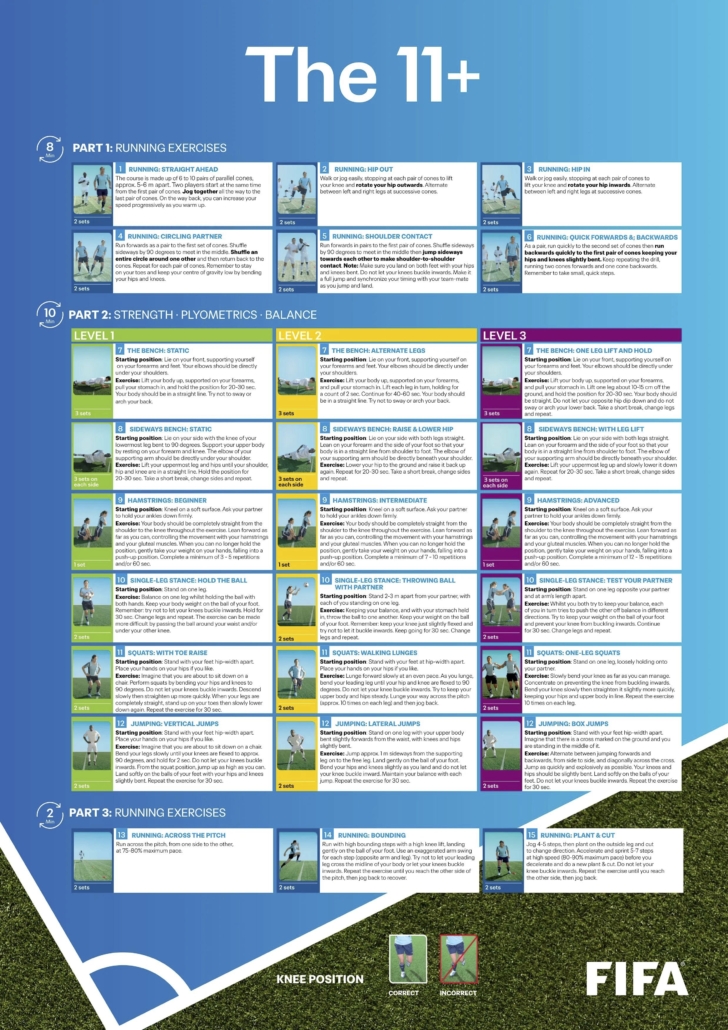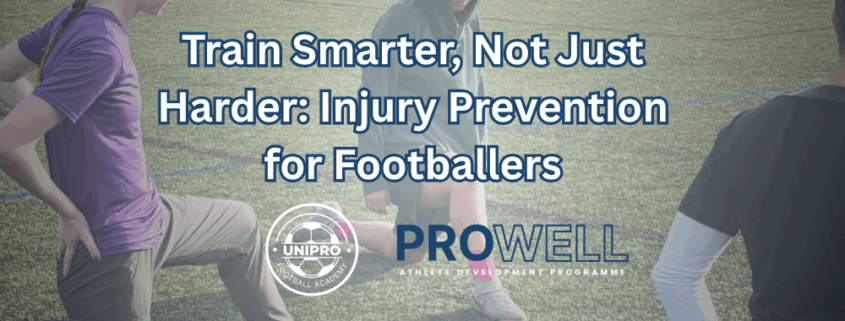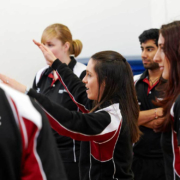Injury Prevention for Footballers
Train Smarter, Not Just Harder: Injury Prevention for Footballers
Injury prevention isn’t just a medical concern, it’s a strategy that should be incorporated into your routine and taken a seriously as training. For aspiring footballers, the ability to stay fit, train consistently, and recover effectively is what allows you to improve, compete, and reach your full potential.
At UNIPRO, we believe in proactive prevention. That means teaching athletes how to move well, condition smart, and respect recovery as part of their training, not something that comes after as a result of an injury or is a second thought.
This blog explores the core principles of injury prevention and how they apply to student-athletes balancing university commitments with elite-level training.
Why Injury Prevention Matters in Football
Football is a high-intensity sport involving rapid acceleration, deceleration, changes of direction, physical contact, and explosive movement patterns. These demands put footballers at risk of injuries such as:
- ACL tears
- Hamstring and groin strains
- Ankle sprains
- Stress fractures
- Tendonitis
But research shows that up to 70% of common football injuries are preventable with structured warm-ups, strength and conditioning, movement education, and proper recovery strategies (for example, teams executing the FIFA 11+ warm-up programme, a structured sequence of running, strength, plyometric and balance exercises have been shown to sustain 30–70% fewer injuries)

The 9 Pillars of Injury Prevention for Footballers
-
Dynamic Warm-Ups & Cool-Downs
A proper warm-up raises your body temperature, improves joint mobility, and prepares your neuromuscular system for action.
Key elements:
- Leg swings, high knees, lunges
- Activation drills for glutes and core
- Ball work and technical drills at game tempo
After training, cool-down with:
- Static stretches (hamstrings, quads, calves)
- Foam rolling to promote circulation
- Light jogging or walking to reduce muscle tension
- Football-Specific Strength and Conditioning
A tailored S&C programme builds the resilience needed to withstand the demands of the game.
Focus areas:
- Lower body strength: squats, lunges, hamstring curls
- Core stability: planks, anti-rotation holds, stability ball work
- Plyometrics: box jumps, bounding, landing mechanics
- Upper body strength: pushing and pulling exercises for posture and contact balanceStrength and Conditioning
-
Flexibility and Mobility Training
Lack of mobility in the hips, ankles, and thoracic spine is a common injury risk.
Add to your weekly routine:
- Hip flexor and hamstring stretches
- Dynamic mobility flows
- Yoga or guided flexibility sessions once a week
-
Running Mechanics & Movement Efficiency
Many soft-tissue injuries stem from poor biomechanics. Learning how to sprint, decelerate, and land safely reduces load on joints.
Drills to include:
- Sprint technique with a slight forward lean and proper knee drive
- Deceleration drills with focus on knee alignment and soft landings
- Agility patterns that mimic game movements (Z-cuts, shuffles, pivots)
- Load Management & Training Intensity Monitoring
Injuries often result from “too much, too soon.” Overtraining without recovery leads to burnout, fatigue, and breakdown.
Best practices:
- Track training volume and intensity weekly
- Schedule rest days and light recovery sessions
- Listen to your body and adjust based on fatigue, soreness and mood.
-
Proper Nutrition and Hydration
Muscles, tendons, and joints recover more efficiently when they’re fuelled properly. Nutritional deficiencies can slow healing and increase injury risk.
Nutritional tips:
- Prioritise protein for muscle repair post-training
- Carbohydrates are essential for fuelling high-intensity sessions
- Stay hydrated with 2.7–3.7L of fluid daily, adjusted for activity and climate.
- Recovery Strategies: Sleep, Active Recovery, and Soft Tissue Work
Recovery is where adaptation happens. Skipping it compromises progress.
Key components:
- 8–9 hours of sleep per night
- Active recovery: low-intensity swimming, cycling, or mobility circuits
- Soft tissue work: foam rolling, massage, contrast baths.
-
Injury Awareness and Early Intervention
Ignoring “minor” pain often leads to major issues later.
Early warning signs:
- Persistent tightness, swelling, or restricted range of motion
- Decreased performance or chronic fatigue
- Compensation patterns when moving or running
Always report discomfort early and work with physios or coaches to modify training accordinglyDoc 1. Key Injury Preve…
-
Mental Preparation and Stress Management
Mental stress increases muscle tension, reduces focus, and impacts movement efficiency making injury more likely.
Injury prevention through mindset:
- Practice visualisation to rehearse safe, confident movements
- Use mindfulness to stay focused and avoid reactive play
- Manage off-pitch stress through journaling or professional support
Building a Smarter Training Plan
At UNIPRO, our injury prevention model is integrated into every part of the programme from strength sessions to tactical drills plus, we dive deeper into the importance of injury prevention in one of our ProWell modules. Here’s a simple template you can apply now:
Weekly Injury Prevention Checklist:
- 2 strength training sessions (lower + upper/core)
- 1 flexibility or yoga session
- Daily warm-up and cooldown protocols
- At least one full rest day
- Sleep, hydration, and nutrition targets met
Final Thoughts
Injury prevention isn’t about being cautious, it’s about being consistent. When you train with intention, listen to your body, and prioritise recovery, you build a foundation for a long and successful playing career.
The athletes who stay healthy are the ones who get the chance to improve. And the ones who improve consistently are the ones who get noticed.
Next blog: We’ll turn our attention to nutrition—how to fuel training, boost recovery, and eat like a high-performance athlete.











